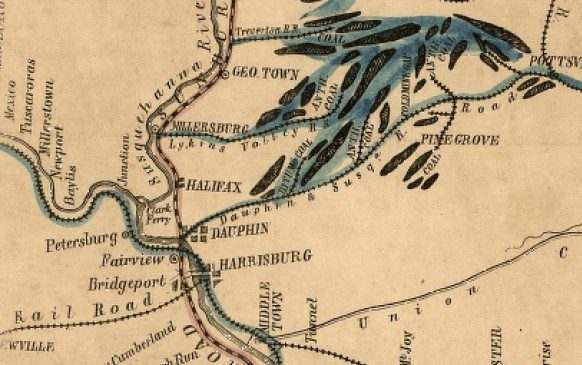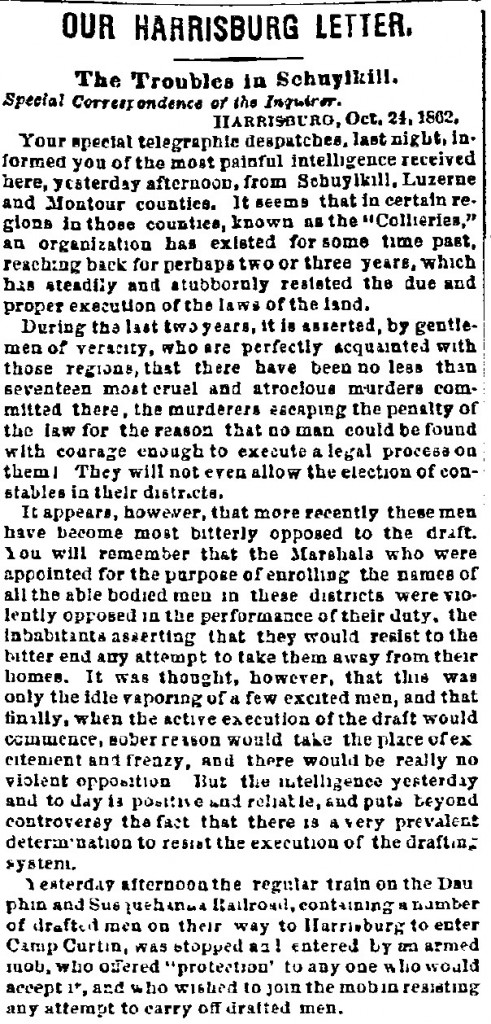Opposition to the Draft of 1862
Posted By Norman Gasbarro on December 7, 2010
Not everyone supported the draft. One case that was noted in a Philadelphia Inquirer article on 25 October 1862 was a group of law resisters in the coal mining area of Schuylkill County referred to as “The Collieries.” Exactly where the group was located in Schuylkill County was not known, but they were allegedly responsible for seventeen murders as well as acts of violent intimidation.
This map of unknown origins of the coal regions shows the area between Pottsville and the Susquehanna River – and the route of the Dauphin and Susquehanna Railroad. The newspaper reported that a mob boarded the afternoon train that was taking a number of draftees to their muster point in the Harrisburg area and tried to get the draftees to join the mob and resist the draft. There was no follow-up on this story, so, whatever the result of this incident, it wasn’t reported.
The Dauphin and Susquehanna Railroad roughly followed the ridge line of Peter’s Mountain, which is the southern boundary of the greater Lykens Valley area triangle, the geographic area of this Civil War Project.
For those who wish to research this further, the text of the article is reproduced below. If anyone finds anything of interest about this incident or other groups in the Lykens Valley area that openly showed resistance to the draft, hopefully, it can be reported here.
Your special telegraphic despatches [sic], last night, informed you of the most painful intelligence received here, yesterday afternoon, from Schuylkill, Luzerne and Montour counties. In seems that in certain regions of these counties known as the “Collieries” an organization has existed for sometime past, reaching back for perhaps two or three years, which has steadily and stubbornly resisted the due and proper execution of the laws of the land.
During the past two years, it is asserted, by gentlemen of veracity, who are perfectly acquainted with those regions, that there have been no less than seventeen most cruel and atrocious murders committed there, the murderers escaping the penalty of the law for the reason that no man could be found with courage enough to execute a legal process on them! They will not even allow the election of constables in their districts.
It appears, however, that more recently these men have become most bitterly opposed to the draft. You will remember that the Marshals who were appointed for the purpose of enrolling the names of all the able bodied men in these districts were violently opposed in the performance of their duty, the inhabitants asserting that they would resist to the bitter end any attempt to take them away from their homes. It was thought, however, that this was only the idle vaporing of a few excited men, and that finally, when the active extension of the draft would commence, sober reason would take the place of excitement and frenzy, and there would be really no violent opposition. But the intelligence yesterday and today is positive and reliable, and pouts beyond controversy the fact that there is a very prevalent determination to resist the execution of the drafting system.
Yesterday afternoon the regular train on the Dauphin and Susquehanna Railroad, containing a number of men on their way to Harrisburg to enter Camp Curtin, was stopped and entered by an armed mob, who offered “protection” to any one who would accept it, and who wished to join the mob in resisting any attempt to carry off drafted men.
 ;
;




Norman –
This map poorly represents the actual location of the Dauphin & Susquehanna Railroad (later renamed the Schuylkill & Susquehanna Railroad), which originally ran from Dauphin, Dauphin County, through Stony Creek Valley (in Dauphin & Lebanon counties) to Pine Grove, Schuylkill County, and eastward to Auburn, Schuylkill County. This places the train incident beyond the southern boundary of the greater Lykens Valley area triangle; however, it is altogether possible that the “Collieries” falls in your geographic area of study.
Thanks for the post, as one of our areas of interest is the history of Stony Valley.
Annette Logan